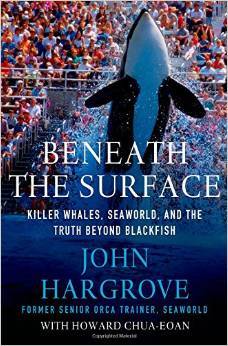What would you do if you were forced to bury secrets about your life and your very being deep inside your soul for years and years? How would you feel if the only job you had ever wanted and known turned out to have a very dark side? Those are the themes explored by John Hargrove, former SeaWorld trainer, in his upcoming book, Beneath the Surface: Killer Whales, SeaWorld, and the Truth Beyond Blackfish. Publisher Palgrave Macmillan has scheduled a hardcover release for March 24, 2015 of Hargrove's personal tale and follow-up to his participation in the multiple award-winning film, Blackfish.
 Hargrove starts his book with a harrowing tale of a near escape from a training encounter with one of his beloved orcas. With 7000 pounds of "killer whale" pushing him around in a tightly enclosed environment, Hargrove had to rely on his wits and training to survive the heart-pumping incident. Escaping what could easily have turned into a life-ending experience at the age of only 27, the author sees this terrifying event as a metaphor for his life and his book. While things may appear calm and controlled on the surface, Hargrove felt there was so much more going on under the surface that needed to be brought to light.
Hargrove starts his book with a harrowing tale of a near escape from a training encounter with one of his beloved orcas. With 7000 pounds of "killer whale" pushing him around in a tightly enclosed environment, Hargrove had to rely on his wits and training to survive the heart-pumping incident. Escaping what could easily have turned into a life-ending experience at the age of only 27, the author sees this terrifying event as a metaphor for his life and his book. While things may appear calm and controlled on the surface, Hargrove felt there was so much more going on under the surface that needed to be brought to light.
A Lifetime of Love and Heartache
Hargrove came to fall in love with orcas at the tender age of six when he first saw them perform during a family trip to SeaWorld Orlando. He became captivated right then and there and knew that they would somehow become a part of his life. On subsequent trips he would pepper the trainers with questions about the orcas and how they were treated. He found out everything he needed to do to become one of the trainers, and focused on building his mind and his body.
His persistence paid off in 1993, as he was offered an apprentice job at SeaWorld San Antonio. After two years, Hargrove was promoted to the position of associate trainer at SeaWorld San Diego. By the time his career ended in 2012, Hargrove had become one of the most experienced orca trainers in the world, and one of the very few who was skilled enough to work with orcas in the water. In total, he worked with 20 whales over his career, swimming with 17 of them. Of the 30 whales that SeaWorld still owns, Hargrove has worked with 12. Due to his many physical injuries and becoming spiritually fatigued, he eventually resigned from a job he loved in August 2012.
While his infatuation with whales was becoming fully realized, Hargrove knew that there was another part of him that needed to be acknowledged. He had recognized that he was a gay teenager living in an incredibly conservative part of Texas, and ran away to try to find his true self. Finding a nurturing community of gay men to support his aspirations, he acquired the necessary skills and knowledge to become an orca trainer. His dreams were almost shattered when Mark McHugh, a childhood idol and new boss at Shamu Stadium told him, "I almost voted not to hire you because I thought you might be gay." Hargrove decided that part of his life would need to be shoved back under the surface in order to achieve his life-long dream of working with the orcas.
The description of his eventual work with orcas is deeply moving. Few humans have ever had the ability to be so up close and personal with these magnificent creatures. The love and respect he feels is palpable. But, even as was living a real-life dream come true, something began to gnaw at his soul about the very idea of keeping orcas in captivity.
What the Audience Doesn't See
While audiences have witnessed some behavioral "incidents" at SeaWorld shows, most are simply amazed at the beauty and power on display as the orcas soar through the air. They never stop to wonder what goes on behind the scenes, or to think about whether captivity is truly the best option for the so-called preservation of the species. They never know that even the beloved Shamu had bitten at least three people, one of whom was a SeaWorld secretary who was taking rides on Shamu as part of a publicity photo shoot.
Hargrove reveals that what goes on under the SeaWorld is a tale of actions motivated solely by corporate greed. Despite his love and admiration, he realized that this was simply not a natural way to protect and care for these animals. In their drive to boost attendance and increase profits, Hargrove likens life for the orcas under SeaWorld's care to that of prisoners in a cell. Although it is impossible to ever know their true feeling, he believes that the orcas must feel as though they have been captured and imprisoned by aliens. Slowly his feelings began to change from whole-hearted advocate for the SeaWorld corporate line to questioning skeptic.
They are transported out of their natural environments and kept in wholly unnatural conditions. Instead of having the entire ocean as a playground, they are cramped into small quarters with chlorinated water in shallow pools that are no match for the ocean depths. Strange diseases attack them, and their bodies suffer damages such as collapsed dorsal fins from the unnatural conditions. A carefully orchestrated social hierarchy is completely ignored when families are torn apart and co-mingled as corporate needs dictate. Female whales are artificially impregnated on a regular basis, often beginning at ages far younger than what would occur naturally, and then cruelly separated from their children. The prisoners come to rely on their keepers for food, but are forced to perform tricks on command in order to be rewarded with life-sustaining nutrition. Whales now born in captivity have no memory of life in the wild and no training from their social peers on how to survive. It's no small wonder that, every so often, one of the whales decides to strike back.
That's what happened on February 24, 2010, when Dawn Brancheau was killed by a 12,000 pound male orca named Tilikum. As a member of their small group, Hargrove considered Brancheau to be one of the most skillful and experienced trainers. Although another trainer had recently been killed at a different park and Tilikum had already been involved in two other deaths, trainers were allowed to continue working with him. SeaWorld was quick to lay the blame for the incident at the doorstep of the trainer. After a public uproar following the release of Blackfish and an OSHA investigation, no SeaWorld trainers have since been allowed into the water to perform with killer whales.
A Glance Into the Future
Once he had officially retired from SeaWorld and his life-long passion, Hargrove came to the startling realization that he had no idea how orcas live in the wild. Given the opportunity to observe these magnificent creatures in their natural habitat helped to further crystallize his concerns about their treatment at SeaWorld and led to his participation in Blackfish, his support of legislation in California and New York to end the practice of keeping killer whales in captivity, and now his publication of this book.
Has all of the attention made a difference? Musical acts such as Heart, Willie Nelson, and REO Speedwagon cancelled their scheduled 2014 performances at the Orlando theme park. In December of 2014 CEO Jim Atchison stepped down after the controversy hit SeaWorld where it hurts most - in the corporate pockets. Attendance fell 5.6%, while profits dropped an astonishing 28% in the third quarter alone, lessening the value of the orcas as a corporate asset.
Perhaps this is the beginning of a downward trend in the public's fascination with performing animals, but even if it is, what will happen then? Some of these orcas were born in captivity and have never known the joys and the dangers of life in the open ocean. Is SeaWorld prepared to take on its responsibility for their rehabilitation or even their care if they are never able to fully readjust? It seems like an unlikely goal without the constant focus of public scrutiny.
But that does seem like the very goal that Hargrove has in mind. By using Beneath The Surface to focus laser attention on the plight of orcas in captivity as well as the harrowing lives of the trainers who work with them, he hopes to effect change in their treatment and their lives. Beneath The Surface is indeed a story of both dread and wonderment - the wonderment of having been so close with such a magnificent species, but intense dread at the cost of that relationship to both parties. For the sake of the orcas and perhaps even humanity, let's all hope that books such as this have the ability to shine a light into the inner workings of corporate greed and redirect efforts from selling tickets to preserving, nurturing and enhancing the orcas' lives.
